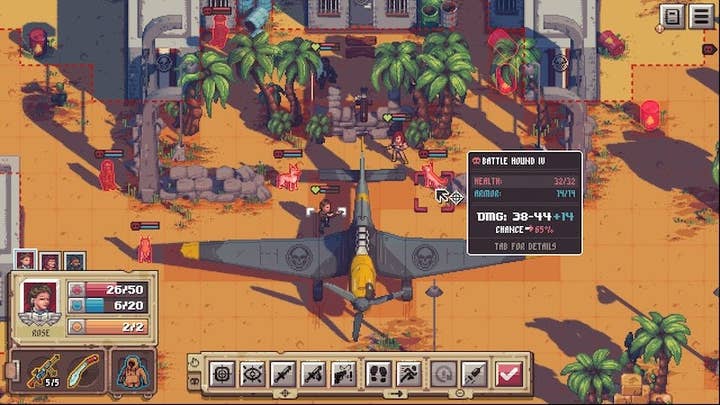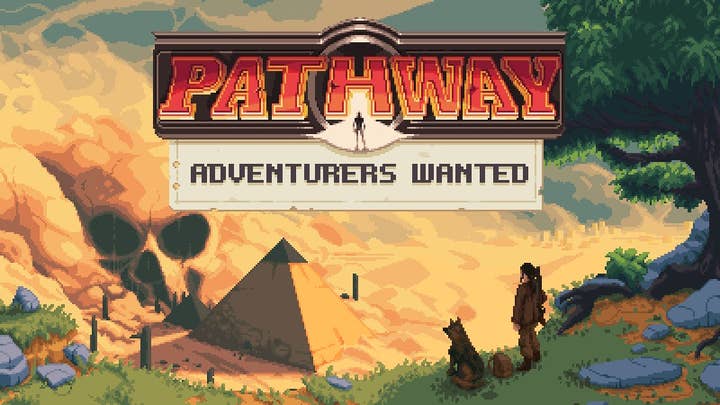Deep dive: Turning around your game's reviews post-launch
Pathway dev Simon Bachmann discusses the game's path from Mixed reviews at launch to a Mostly Positive success
The GameDiscoverCo game discovery newsletter is written by 'how people find your game' expert and GameDiscoverCo founder Simon Carless, and is a regular look at how people discover and buy video games in the 2020s.
Pathway and post-launch expectation management
Something we've been fascinated by here at GameDiscoverCo? The concept that 90% of games have a 'Hype' problem (not enough people know about it). But 10% of games have an 'Expectation' problem (people know about it, but what you deliver might not be 100% what they expected).
And we were lucky enough to talk about this to Simon Bachmann of dev Robotality about his team's Chucklefish-published title Pathway. The game is a fetching pixel art-based 2D title where you "unravel long-forgotten mysteries of the occult, raid ancient tombs and outwit your foes in turn-based squad combat!"
Pathway's first month on sale on Steam back in April 2019 had about 350 Positive and 210 Negative reviews, a "Mixed" result that could become an anchor weighing down sales. But the team kept working on it, with only about 200 more Negative reviews during its LTD on Steam from the 1,100+ reviews since launch month, a way better percentage. (It also launched a Switch version last year.)
So we talked to Simon about both expectation management (why he thinks people didn't get the correct impression of the game at launch), and what happened after that (the route to improving review scores and long tail sales).
Q: After the initial 2019 launch of Pathway, it seems like reviews were just 'OK', or a bit mixed. Do you have a strong feeling about why that was? Did you release a bit too early, were people expecting different things from what you delivered, etc?
A: I think it was a mix of both: we knew that the game had some rough edges and elements we would have liked to have polished up before the release. But we were on a tight deadline due to our budget, so we had to move ahead and release the game.
We were not expecting that much negative feedback, though. In combination with some wrong expectation handling on our side, this led to an unfortunate combination.
We started out very strong, going right up to the top on Steam's global charts. We also had a lot of media coverage and big streamers playing the game at launch. But soon, more and more negative reviews started coming in.
And when we finally hit a mixed overall review score, sales started to take a dive. Of course, we took a very close look and tried to analyse what went wrong here. The result was quite clear:
● The gameplay core loop was not as fun as we had hoped, and a lot of players complained that it felt like a grind.
● Players expected a different game with more content than what we had. The game felt repetitive, even though it had a lot of content. Basically, we did not present it the best way possible and that combined with the feeling of having to grind… it felt like a chore. Content in general was just lacking a bit, and we had stretched it too thin.
● A lot of players expected an FTL and XCOM mash-up in an Indiana Jones outfit. What we aimed for was a fast-paced, approachable turn-based game instead. After seeing the media also use similar descriptions, we tried to change the way we communicated the game. But unfortunately, comparisons were still drawn.
● Even though the story events had a lot of options, not many of the choices felt meaningful.
● Some players experienced technical difficulties, as our game was built on a custom engine to support the visual style we're going for.

Q: Can you explain what plans you had for post-release content initially? Did they change after you saw the reception to the game?
A: We always planned to wait and see what the players enjoyed most, before deciding what we are going to do next. And we did have plans to have some more content after release.
Before we released the game we thought it would be in the form of new adventures. But after the initial feedback we decided to instead focus on making the existing content more meaningful and interesting. We re-worked and re-balanced a lot of aspects of the game.
Q: How did you keep the morale of the team high after a mixed launch? Were you sure you wanted to keep working on the game?
A: Well, that was a tough one obviously. Especially in the contrast of being the worldwide top seller on Steam and 24 hours later having mixed reviews and not selling many copies anymore…
So yeah, that sucked. It helped a lot that we were all experienced in releasing games, and we knew that this was going to be the most stressful part. We just did not expect it to be *that* stressful. [winking emoji]
We eventually just hunkered down and started to fix the most obvious and easy to fix issues that came up. We started talking as a team to find out what we can do to improve the game long-term.
It also helped enormously that we had a partner in the form of Chucklefish. They were super supportive and helped us to navigate all this. Communication with the community was a challenge during these times, and we relied heavily on Chucklefish to help us with this.
So the first one or two months were a blur and we addressed a ton of smaller issues. Then we really began to deconstruct the whole game and rebuild parts from scratch. When we finally had a good idea of what we wanted to make, things came back into focus. We had a goal in sight and just worked towards it.
We also knew that if we managed to get the game back to a positive reception, we had a much, much better chance of making it commercially successful. We invested a big chunk of the initial revenue from Pathway back into the game and started working on multiple bigger updates that really improved the core of the game.
Q: Could you identify the major game updates you ended up doing after launch, why you decided to do them in that order, and the general reception of them?
A: Our first major content update was Adventurers Wanted. It introduced a new character system. We also nearly doubled the amount of content you could encounter, rebalanced a lot of things from the ground up. At this point we had a pretty fantastic community that was also invested in the game and helped us shape some of these aspects directly.
Besides adding hundreds of new events, we also touched every existing event and added new options to them to make them more interesting and actually interesting to play multiple times.
That update was the one that turned around the overall ratio of new reviews being mainly positive. We followed up with more updates that added a Hardcore mode, controller support, and more. Around the time we released the Hardcore mode to the public we also finally reached an overall positive review score again.
This took a lot of time, as it's nearly impossible to get people to change their review once they put one down. So you have to convince new players to play the game and rate it. It's also difficult to drive awareness of these changes, as media aren't as likely to cover news about such updates.
Winning the German Developer Award for "Best Story" at the end of 2019 right after we released the Adventures Wanted update generated a lot of positive feedback, and it was a very cool way for us to finish off a rather stressful year. [Smiling emoji]

Q: We see you added community language support relatively recently, and the game originally shipped in a few (but not all) of the major languages. Can you explain why you decided to do that?
A: This is an interesting one. We had always planned to only have support for the five initial languages, as they were the ones that reflected the player base from our previous game: English, German, French, Chinese and Japanese. At some point, fans started to translate the game into Italian and other languages without us prompting.
And let me tell you, Pathway is a monster to translate. There are over 150,000 words in this game. So, one player contacted us a year or so back and asked if it was okay for him to translate the game to Italian in his free time. We of course had nothing against that, and provided him with the tools he needed. After that, multiple other people started translating the game, so we made those tools available for them as well.
To our surprise, they actually finished translating the game and releasing them to the community. We thought about how to best help them get the translations to as many players as possible, without us having to patch them in-game. We didn't want to add the fan-made translations directly to Pathway, as this would have required proofreading and testing resources we don't have, not to speak of any potential legal hurdles.
So we decided to integrate Steam Workshop into Pathway, so that fans translating the game could share their work easily with other players. That way they also remain in full control over their own work. The decision was mainly to support our community who had dedicated a huge amount of their free time to translate a game they enjoyed playing. We felt like giving them a bit of a platform to share their work was the least we could do.
Q: Do you think the improvement in positive review percentage after launch shows the success of your strategy of updating the time over time? Is it also that people now understood what to expect from the game based on all the other reviews? Both?
A: I think multiple things made this a [post-launch] 'success story,' if you'd like to call it such. With the first big update, Adventures Wanted, we managed to create an objectively much better game that is just more fun to play than the initial release was.
Second, we put a lot of effort in managing player expectations: One thing we did for example was a second gameplay trailer we released with our first major update. It explains what Pathway is (and maybe more importantly what it is not), so players can decide if the game is for them without having to play it.
This goes back to the previous point: players expected XCOM-style combat, but that just wasn't our goal with the game. With this video we tried to clear those things up for players interested in the game.
I think in terms of marketing, making a big hype around a game is only one side of the story. Managing expectations on what the game actually is can be just as important if you want to have happy customers. In some ways we were quite successful in building up pre-launch hype, but overlooked the second part a bit. To sum up: I'd rather have one less customer than an unhappy one.
GameDiscoverCo is an agency based around one simple issue: how do players find, buy and enjoy your premium PC or console game? You can subscribe to GameDiscoverCo Plus to get access to weekly game analysis and detailed charts, plus the newsletter, an info-filled Discord, a data-exportable Steam Hype back-end, two high-quality eBooks, and lots more.

